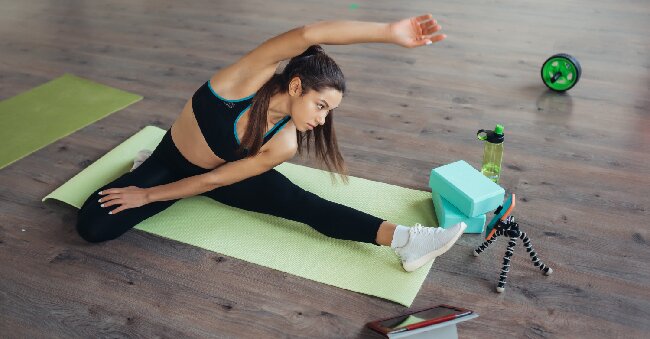
Yoga Bricks 101: 7 Essential Tips to Enhance Your Practice
For individuals looking to enhance their yoga practice and elevate it to the next level, yoga bricks may be a valuable addition to the routine.
This comprehensive guide delves into the various advantages of incorporating yoga bricks, selecting the most suitable option, the range of available types, and methods for integration into one’s practice.
Additionally, advice on correct usage and upkeep will be offered to maximize the benefits of yoga bricks. Let us explore further and enhance your yoga experience!
What Are the Benefits of Using Yoga Bricks?
Yoga bricks provide various benefits for yoga enthusiasts, such as increased stability, support, improved alignment, and posture. They can also enhance flexibility and range of motion during yoga sessions, catering to both beginners and experienced practitioners.
Incorporating yoga bricks into one’s practice can elevate the yoga experience. For instance, in poses like supported bridge or supported fish pose, using a yoga brick under the sacrum can help maintain proper alignment and deepen the stretch. Even in fundamental poses like downward-facing dog or extended side angle, yoga bricks can assist in achieving proper alignment and extending the range of motion. These props are particularly beneficial for individuals with limited flexibility, allowing for gradual progression in challenging poses.
1. Increased Stability and Support
Yoga bricks are props that offer added stability and support during yoga poses, aiding practitioners in maintaining correct alignment and balance.
These props are versatile and can be especially helpful for beginners or people with restricted flexibility. For instance, in a standing forward bend, using a yoga brick under the hands can lessen pressure on the hamstrings and lower back, enabling a more comfortable stretch without sacrificing form. In poses like supported bridge or supported fish, placing yoga bricks strategically under the sacrum can assist in opening the chest and shoulders, providing support to the spine and enhancing the accessibility and effectiveness of the poses.
2. Improved Alignment and Posture
The use of yoga bricks can help improve alignment and posture by offering extra height and support in areas where necessary, enabling practitioners to attain more accurate positioning in their poses.
Incorporating yoga bricks into one’s practice can aid in achieving proper alignment in various poses. For instance, when performing a seated forward bend, placing a brick under the hands can assist in elongating the spine and maintaining a straight back. Likewise, utilizing a brick to bolster the hips in a seated posture can prevent the spine from rounding and encourage better posture. The crucial aspect is to determine the appropriate placement and height of the brick to provide support to the body while still challenging the individual to engage their muscles for stability.
3. Enhanced Flexibility and Range of Motion
Yoga bricks can aid in improving flexibility and expanding the range of motion for practitioners by providing support during stretches and aiding in achieving challenging yoga poses comfortably and securely.
Integrating yoga bricks into one’s practice allows for the adjustment of poses to match the current level of flexibility and the gradual progression towards more complex variations. For instance, placing a brick under the hand during a forward fold can reduce the distance to the floor, making the pose more attainable and enabling focus on elongating the spine. Using bricks to bolster the hips in seated poses such as pigeon or cow face pose can help uphold proper alignment and promote a deeper stretch in the hips and thighs.
How to Choose the Right Yoga Brick?
The process of choosing the right yoga brick involves taking into account factors such as material, size, and density, all of which can impact its effectiveness in offering support and assistance during yoga practice.
The material of the yoga brick plays a crucial role in determining its durability and comfort level. Yoga bricks are commonly made from materials like foam, cork, and bamboo, each with its own unique benefits.
Foam bricks are lightweight and offer cushioning, making them suitable for beginners or individuals requiring gentle support. Cork bricks are environmentally friendly, firm, and provide excellent stability. Bamboo bricks are known for their durability and sustainability.
The size of the brick affects how it supports different yoga poses, with smaller bricks allowing for more precision and larger ones offering broader support. The density of the brick determines its firmness, influencing the level of support it provides during various yoga poses.
1. Material
When selecting a yoga brick, it is important to consider the material it is constructed from, such as foam, wood, or cork, as each material has distinct characteristics in terms of firmness, grip, and durability.
Foam yoga bricks are light in weight and offer a soft yet supportive surface, making them suitable for beginners or individuals in recovery from injuries. They are cost-effective, easy to clean, but may lose their shape over time with frequent use.
Conversely, wooden yoga bricks are robust and long-lasting, providing excellent support and stability during yoga poses. They are heavier and less forgiving on impact compared to foam bricks.
Cork yoga bricks are eco-friendly, offering a firm surface and natural grip that enhances stability in various postures. Despite being more expensive, cork bricks are durable and maintain their shape well over time.
2. Size
The size of a yoga brick is important for its usability and comfort during practice, as different sizes are suited to various body types and flexibility levels.
Selecting the appropriate size of a yoga brick can improve yoga sessions by providing the right level of support for the body. For individuals with smaller body proportions, a smaller brick may be more suitable to prevent strain in poses. Conversely, taller individuals might find a larger brick beneficial for maintaining proper alignment.
Consider your intended use as well; softer bricks are preferred for restorative poses, while firmer ones provide stability for challenging asanas. By choosing the size of your yoga brick accordingly, you can ensure optimal comfort and alignment in different poses.
3. Density
The density of a yoga brick plays a key role in determining its firmness and stability, impacting the level of support it offers and the sensation it provides during different poses.
Choosing the appropriate density of a yoga brick is essential for improving one’s yoga practice. Bricks with higher density offer greater firmness and stability, making them ideal for individuals in need of strong support in challenging poses. On the other hand, bricks with lower density offer a softer feel, which may be more suitable for gentle stretches or restorative postures.
It is important to take into account one’s strength levels and comfort preferences when deciding on a yoga brick, as the right density can significantly influence the overall experience of the practice.
What Are the Different Types of Yoga Bricks?
Yoga bricks are available in different types, such as foam bricks, wooden bricks, and cork bricks. Each type offers distinct features and benefits for practitioners seeking to enhance their yoga practice.
Foam bricks are lightweight and offer a soft yet supportive surface for yoga poses, making them well-suited for beginners or individuals with sensitivity. In contrast, wooden bricks are sturdy and provide a stable base, which can appeal to those who prefer a firmer foundation during their practice. Cork bricks are environmentally friendly and strike a balance between support and comfort, making them a suitable choice for experienced yogis seeking a sustainable option that also aids in alignment and balance in challenging poses.
1. Foam Bricks
Foam bricks are lightweight and offer moderate support, making them suitable for beginners and individuals looking for gentle assistance in yoga poses that require less height or firmness.
These versatile props are crafted to help practitioners achieve proper alignment, improve stability, and enhance comfort during a variety of yoga postures. Whether it involves adding extra height, aiding in balance poses, or supporting the spine in seated positions, foam bricks provide a gentle yet effective method to enhance your practice. Their soft yet firm texture is gentle on the body, ensuring accessibility for practitioners of all skill levels. Integrating foam bricks into your routine can facilitate the exploration and refinement of your practice with added convenience and ease.
2. Wooden Bricks
Wooden bricks are known for their firm support and durability, which makes them a suitable choice for advanced practitioners or individuals seeking a stable and long-lasting prop for their yoga sessions.
Their solid construction ensures that they maintain their shape and integrity even after prolonged use, providing dependable support during complex poses. The stability they provide assists in achieving proper alignment, enabling practitioners to deepen their stretches while minimizing the risk of injury. This increased stability can also help in developing strength and balance, particularly in challenging postures that require additional support. The versatility of wooden bricks makes them a valuable tool for experienced yogis looking to progress their practice and improve their alignment.
3. Cork Bricks
Cork bricks are known for being eco-friendly, offering good grip, and providing moderate firmness. This makes them a sustainable and comfortable option for practitioners who value both performance and environmental considerations.
In the realm of yoga practice, cork bricks are recognized for their versatility as props that offer excellent grip and support. They help enhance stability and alignment in a wide range of poses. The natural texture of cork material not only helps prevent slips but also conforms to the practitioner’s body, creating a stable foundation for various yoga postures.
The sustainability aspect of cork bricks adds another layer to one’s practice, allowing yoga practitioners to align their values with their poses. By integrating cork bricks into their routines, practitioners can enrich their practice while supporting environmental consciousness.
How to Use Yoga Bricks in Your Practice?
Incorporating yoga bricks into a yoga practice can provide essential support in standing poses, improve alignment in seated poses, offer modifications in inversions, and enhance stability in balancing poses for a well-rounded yoga session. These versatile props can be utilized in a myriad of ways to deepen a practice and help advance in a yoga journey.
For standing poses like Triangle Pose, placing a brick under a hand can extend reach and provide stability. In seated poses such as Pigeon Pose, using a brick under a hip can help align hips and pelvis. In inversions like Headstand, placing a brick against a wall can assist in maintaining proper alignment. For balancing poses like Tree Pose, holding a brick between hands can improve focus and stability.
1. For Support in Standing Poses
Using yoga bricks for support in standing poses can help maintain balance, prevent strain, and deepen stretches, allowing practitioners to achieve better alignment and stability in challenging postures.
Incorporating yoga bricks in standing poses can help individuals gradually improve their balance and alignment. For example, in poses like Triangle Pose (Trikonasana), placing a brick under the hand can assist in comfortably reaching the floor, ensuring proper form and alignment. Similarly, in Warrior III (Virabhadrasana III), using a brick under the supporting hand can help stabilize the pose, allowing for a longer and more sustained hold to strengthen the muscles while maintaining a steady balance.
2. For Alignment in Seated Poses
Yoga bricks can be used to assist in achieving proper alignment in seated poses by elevating the hips or providing support to the spine. This helps maintain optimal posture and comfort, especially during longer holds or deeper stretches.
Strategically incorporating yoga bricks into your practice can help align your hips with your knees, creating a natural curve in the lower back and reducing strain. Placing a brick at the base of the spine can offer support, elongating the torso and enabling a deeper forward fold while maintaining alignment. This additional support promotes relaxation, allowing you to fully participate in the pose and benefit from both the physical advantages of proper alignment and the mental rewards of heightened focus and breath awareness.
3. For Modifications in Inversions
When practicing inversions, yoga bricks can provide stability, height, and support to modify poses like headstands or shoulder stands. This allows practitioners to improve their strength and confidence in upside-down postures.
These props are versatile tools that assist in enhancing the practitioner’s alignment by facilitating proper placement of hands or head, particularly beneficial for beginners or individuals refining their technique. By strategically incorporating yoga bricks, individuals can progressively advance towards deeper inversions as they enhance their strength and flexibility. The supportive nature of yoga bricks helps reduce strain on the neck and shoulders, promoting balanced weight distribution and facilitating a safer progression in demanding poses.
4. For Stability in Balancing Poses
Yoga bricks can assist in enhancing stability and confidence during balancing poses by providing a sturdy base, minimizing instability, and offering extra elevation or assistance as necessary to enhance alignment and concentration.
When incorporating yoga bricks into balancing poses, individuals have the option of positioning the brick either vertically or horizontally to cater to different levels of challenge. Placing the brick vertically can help elongate the stretch in poses like Half Moon, enabling a deeper extension while ensuring steadiness.
For poses that require added elevation, such as Tree Pose, situating the brick horizontally beneath the foot can help establish equilibrium and proper alignment. It is important to activate the core muscles, concentrate on breathing, and focus on mindfulness to enrich the overall pose experience.
Tips for Properly Using Yoga Bricks
To optimize the benefits of yoga bricks, begin by choosing the appropriate size and density, utilizing them as a guide rather than a crutch, and being attentive to your body for comfort and stability during your practice.
When selecting the size of your yoga brick, go for one that allows you to maintain proper form without causing strain. A denser brick offers more support, particularly for balancing poses. Introduce bricks gradually into your routine, starting with basic poses like supported bridge or seated forward fold. Experiment with different placements to determine the most effective for your body. Keep in mind that the objective is to improve your practice, enhancing strength and flexibility, instead of pushing yourself into uncomfortable positions. Safety and alignment should be the top priorities for a fulfilling and rewarding practice.
1. Start with the Right Size and Density
Begin by selecting yoga bricks with the appropriate size and density that suit your body proportions and comfort level, ensuring that they offer adequate support and stability without causing strain or discomfort.
When choosing the right size and density of yoga bricks, it is essential to remember that customization is key to maximizing your practice. Testing various brick sizes under different poses can help you determine what feels most comfortable and offers the best alignment. It’s advisable to start with a standard size and density and then gradually adjust based on your personal preferences and requirements. By prioritizing your individual needs, you can achieve optimal support and alignment, enhancing the safety and effectiveness of your yoga practice.
2. Use the Bricks as a Guide, Not a Crutch
Yoga bricks can be viewed as tools to assist with your practice and improve your alignment, rather than being solely relied upon as support aids. This approach encourages incremental advancement and self-sufficiency throughout your yoga experience.
Incorporating yoga bricks into your routine should involve strategic use to enhance your poses, boost your balance, and refine your alignment. It is recommended to strike a balance between using the bricks for stability and gradually reducing their reliance. Through practicing mindfulness and body awareness, you can develop confidence in maintaining equilibrium and strength without solely leaning on the bricks for support. Experimenting with using a single brick instead of two, or trying out different pose variations, can help assess your stability and development.
Embrace the process of developing strength, flexibility, and self-reliance by thoughtfully incorporating yoga bricks into your practice.
3. Listen to Your Body
Take note of your body’s feedback when using yoga bricks, adjusting their placement or usage to ensure comfort, alignment, and the sensations felt during various poses.
During your yoga practice with bricks, remain aware of how your body reacts to the support provided. Identify any areas of tension or resistance and consider adjusting the placement of the bricks to relieve pressure points and improve stability. By making these modifications, you can establish a deeper connection with your body and enhance your practice to a more intuitive level.
Keep in mind that the objective is not solely to utilize the bricks for support but to use them in a manner that enhances your alignment and overall well-being.
How to Clean and Care for Your Yoga Bricks?
To keep your yoga bricks clean and long-lasting, it is recommended to regularly wipe them down with a damp cloth, gentle soap, or natural cleaners. Storing them in a dry, well-ventilated area is also important to prevent moisture buildup and prolong their lifespan.
For maintaining the quality of your yoga bricks, it is crucial to clean them after each use to eliminate sweat and dirt that can foster bacteria. Using eco-friendly cleaning solutions such as a water and vinegar mixture or a mild detergent can provide a deeper clean.
When storing your yoga bricks, avoid placing heavy items on them or exposing them to direct sunlight as this may cause warping or deterioration. Instead, opt for a storage bag or designated shelf to keep them organized and shielded.




No Comments